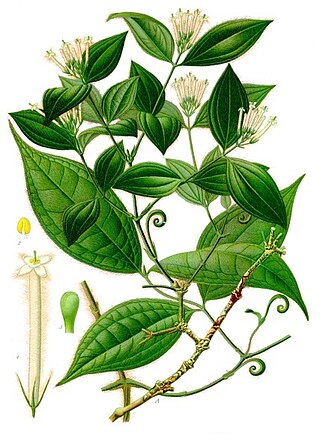Sycamore is a name which has been applied to several types of trees, but with somewhat similar leaf forms. The name derives from the ancient Greek συκόμορος (sūkomoros) meaning "fig-mulberry".

Lagerstroemia, commonly known as crape myrtle, is a genus of around 50 species of deciduous and evergreen trees and shrubs native to the Indian subcontinent, southeast Asia, northern Australia, and other parts of Oceania, cultivated in warmer climates around the world. It is a member of the family Lythraceae, which is also known as the loosestrife family. The genus is named after Swedish merchant Magnus von Lagerström, a director of the Swedish East India Company, who supplied Carl Linnaeus with plants he collected. These flowering trees are beautifully colored and are often planted both privately and commercially as ornamentals.

Strychnos is a genus of flowering plants, belonging to the family Loganiaceae. The genus includes about 100 accepted species of trees and lianas, and more than 200 that are as yet unresolved. The genus is widely distributed around the world's tropics and is noted for the presence of poisonous indole alkaloids in the roots, stems and leaves of various species. Among these alkaloids are the well-known and virulent poisons strychnine and curare.

Cryptocarya is a genus of evergreen trees belonging to the laurel family, Lauraceae. The genus includes more than 350 species, distributed through the Neotropical, Afrotropical, Indomalayan, and Australasian realms.

"Jawaharlal Nehru Tropical Botanic Garden and Research Institute", renamed in the fond memory of visionary Prime Minister of India Shri Pandit Jawaharlal Nehru is an autonomous Institute established by the Government of Kerala on 17 November 1979 at Thiruvananthapuram, the capital city of Kerala. It functions under the umbrella of the Kerala State Council for Science, Technology and Environment (KSCSTE), Government of Kerala. The Royal Botanic Gardens (RBG), Kew played an exemplary and significant role in shaping and designing the lay out of the JNTBGRI garden in its formative stages.

Agathis macrophylla known as Pacific kauri, is a coniferous tree native to the islands of the southwestern Pacific Ocean in tropical humid lowlands and lower montane regions, notably in Fiji, Vanuatu, the Santa Cruz Islands, and the Solomon Islands. The Pacific kauri is one of the largest and fastest growing species in its genus, and is important in forestry.
Grewia turbinata is a species of flowering plant in the family Malvaceae sensu lato or Tiliaceae or Sparrmanniaceae. It is found only in Yemen. Its natural habitat is subtropical or tropical dry forests.

Cryptocarya glaucescens, commonly known as jackwood, is a rainforest tree of the laurel family growing in eastern Australia.
Beilschmiedia bancroftii is a tree species in the family Lauraceae. It is native to Queensland in Australia. Common names include yellow walnut, yellow nut and canary ash.

Cryptocarya laevigata, known as the glossy laurel or red-fruited laurel, is a rainforest plant, which ranges from Malesia and New Guinea to eastern Australia. In Australia it grows in the rainforest understorey on fertile soils, from the Richmond River, New South Wales to Cairns in tropical Queensland, where it is often seen in association with the White Booyong.

Cryptocarya triplinervis is a rainforest tree growing in eastern Australia. Common names include the three veined laurel, three veined cryptocarya and the brown laurel.

Cryptocarya bidwillii, the yellow laurel, is a small to medium-sized tree in the laurel family. Occurring in Australian rainforests from Nymboida in the state of New South Wales to Townsville in tropical Queensland. Often found in the dryer ridges in dry rainforest or in viney scrubs.

Southern Afrotemperate Forest is a kind of tall, shady, multilayered indigenous South African forest. This is the main forest-type in the south-western part of South Africa, naturally extending from the Cape Peninsula in the west, as far as Port Elizabeth in the east. In this range, it usually occurs in small forest pockets, surrounded by fynbos vegetation.
Cryptocarya onoprienkoana, commonly known as the rose maple, is a species of rainforest tree of northeastern Australia.

Garcinia sessilis, commonly known as heilala in Tongan, is an evergreen tree native to the Pacific regions of Tonga. The heilala flower is the national flower of Tonga.

The Vogelkop–Aru lowland rain forests is a tropical moist forest ecoregion in Indonesia. The ecoregion covers the peninsular lowlands of western New Guinea, along with the Aru Islands and other nearby islands.
Orbivestus turbinata is a plant in the family Asteraceae, native to tropical Africa.

The Tongan tropical moist forests is a tropical and subtropical moist broadleaf forests ecoregion that includes the Tonga archipelago and Niue.

The Yapen rain forests is a tropical moist forest ecoregion in Indonesia. The ecoregion covers the island of Yapen and smaller neighboring islands which lie north of New Guinea.

Cryptocarya anamalayana is a rare rainforest tree endemic to the southern Western Ghats, India. The specific epithet of the name refers to the Anamalai Hills, a major area of its distribution. The species considered endangered under the IUCN Red List of Threatened Species.














